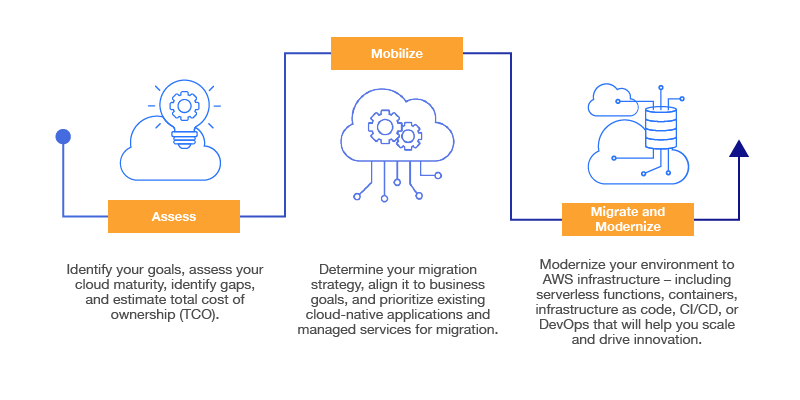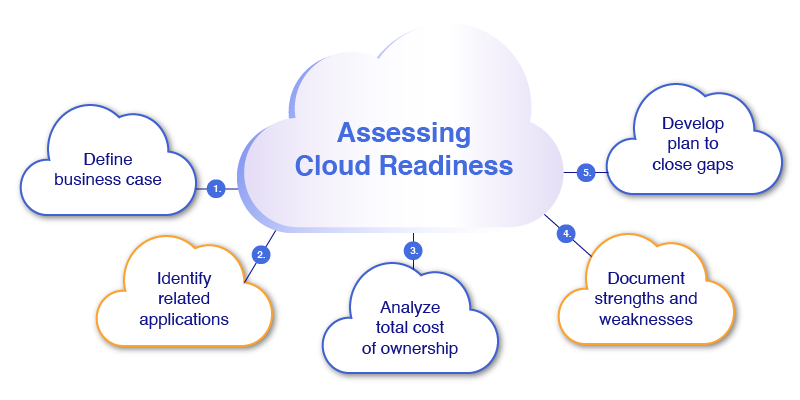Background
By now, most organizations have moved some of their data or applications to the cloud. More than 60% of corporate data is now stored in the cloud, and analyst firm Gartner says 85% of enterprises will have a cloud-first principle by 2025.
Despite the proliferation of cloud computing, cloud migrations are not as easy as one might expect. They can be complicated undertakings that involve numerous assessments of existing resources, re-architecture of applications, alignment of IT and business goals, consideration of governance and security, and detailed cost assessments.
Having a structured approach to complex cloud migrations can simplify and accelerate the effort while reducing the risks of errors and delays. One approach is the AWS Migration Acceleration Program (MAP), a comprehensive and proven cloud migration program based on AWS’s experience migrating thousands of enterprise customers to the cloud.
This program follows three steps:
- Assess your readiness
- Mobilize your resources
- Migrate and modernize your workloads

Wavicle Data Solutions is an AWS Advanced Tier Service Partner well-versed with AWS MAP. In this guide, we’ll explain how this program can facilitate a smooth and seamless cloud migration.
Assess your readiness
The Assess phase is about defining a business case, identifying and prioritizing the applications and data that must be migrated, and analyzing their total cost of ownership (TCO), including the cost of on-prem servers, licensing, people skills, support, and technology.
In this phase, you’ll assemble key stakeholders to evaluate the opportunities and risks of cloud migration and gain consensus on your journey forward. It’s important to document your current-state cloud readiness, understand your organization’s strengths and weaknesses, and develop a plan to close any gaps.
As a team, you must ask some questions to determine what, why, how, and when you’ll migrate specific applications to the cloud.
For example, a media and entertainment company may determine that its on-premises data environment fails to meet the need for fast insights into various areas of the business, such as CRM, order management, billing, provisioning, and reconciliation. The company’s product catalog and partner ecosystem have become large and complicated. It’s now time-consuming and difficult to integrate large volumes of data from multiple sources and generate the timely intelligence that informs decision-making.
For this organization, a move to the cloud may involve migrating its data warehouse; extract, transform, and load (ETL) solution; and data visualization applications. But they can’t do all of this at once, so it’s important to prioritize these efforts.
One way to do this is to compare the business value of each application with the technical feasibility of migrating them. With this exercise, clear priorities will emerge, and you can begin to evaluate which cloud migration approach meets your objectives for each application.
AWS offers tools to support this process, including the AWS Migration Readiness Assessment (MRA), to help facilitate this phase and determine the most effective approach to the cloud migration effort.
There are six common migration strategies, often referred to as the 6Rs, including:
- Rehost: “Lifting” or copying your applications, workloads, or databases from on-premises applications or servers to the cloud with no changes
- Replatform: Going beyond “lift and shift” to make some optimizations that allow you to take advantage of cloud benefits, but most of the infrastructure doesn’t change
- Refactor: Modifying applications to optimize them for the cloud, also known as re-architecting
- Re-Architect: Starting from scratch with an entirely new, cloud-native application
- Retire: Eliminating applications that are no longer useful for your business needs
- Retain: Retaining applications where they are, perhaps because they are functioning optimally or are required to remain on-premises for compliance or other reasons
Your migration strategy may differ for each workload. For example, a single application might have multiple workloads and each workload can have a different migration strategy. Choosing your migration method is an integral part of your migration plan. Of all the methods for migrating to the cloud, the rehost approach remains the easiest, low-risk, fastest, and least expensive way to start operating in the cloud. The re-architect approach is quite the opposite with the benefit of re-imagining how you do your business and serve your customers based on market or industry trends.

Mobilize your resources
Now that you’ve completed your assessment, it’s time to “mobilize” your resources. During this phase, you will refine the business case and create a migration plan. In the last phase, you identified gaps in your organization’s readiness. In this phase, you’ll begin to close these gaps, with a focus on building your baseline environment (the “landing zone”), defining your governance policies, and driving operational readiness.
Some key elements of the Mobilize phase are:
- Business case refinement: Leveraging information from the Assess phase, you’ll create a detailed, multi-year business case that will help prove the value of cloud migration and align migration priorities with business requirements. This includes calculating your current and future total cost of ownership as well as the expected return on investment (ROI) of the migration.
- Application migration: Includes migrating some of your applications to the cloud as you hone your team, skills, culture, and operations, leading to a repeatable, scalable migration approach. Key questions raised at this stage are:
- In what order will the workloads be migrated?
- How will the migration happen with minimal downtime?
- How will the progress of the migration be tracked?
- AWS landing zone: A safe place that is provisioned in the cloud, which serves as a starting point for deploying workloads and applications. The landing zone is an environment that provides a baseline for getting started with many of the elements that get overlooked in migration planning – such as multi-account architecture, identity and access management, governance, data security, network design, and logging.
- Security, risk, and compliance: Address minimum baseline security and compliance controls to ensure that your data and applications are secure at every level. This includes developing clear guidelines and best practices around identity access
When helping our clients with their cloud migrations, we follow the AWS Well-Architected Framework to evaluate their architectures against cloud best practices, identify high-risk areas of concern, and provide guidance for making improvements. We highly recommend that you also leverage this framework to ensure your infrastructure is secure, resilient, efficient, and high performing.
Migrate and modernize
The culmination of the cloud migration journey is the Migrate and Modernize phase. You’ve earned this moment because up to this point, you’ve done a lot of work in assessing, analyzing, resourcing, and provisioning your basic landing zone for initial testing and production. In this third stage of the cloud journey, you’re finally able to migrate at scale.
Here, we look to move beyond a basic landing zone concept to building your cloud migration into more advanced strategies, such as re-platforming into a microservice architecture. Now, all the hard work has paid off and you can eagerly integrate and explore many of the additional services that are often identified as true “cloud nirvana” – such as serverless functions, containers, infrastructure as code, or DevOps, which will help you scale and drive new levels of innovation.
Many AWS partners, including Wavicle, offer AWS Immersion Days, which are technical workshops focused on AWS topics of interest and delivered by certified AWS solution architects. These are a great way to build your team’s familiarity and confidence in modernizing applications with AWS services and learn how to use the platform to most effectively meet your objectives.
Reduce cost and accelerate the success of your cloud migration
Digital transformation is more important than ever and getting to the cloud is the essential ingredient for innovation and competition. However, many businesses today get stuck with “analysis paralysis,” budget issues, and several other obstacles to progress.
An AWS partner can help make your migration a success by giving you a structured approach to planning and executing your cloud migration. With the AWS Migration Acceleration Program, some AWS partners may be able to offer you support to offset the initial cost of your migration and kick off your project faster.
“This is an incredibly important partner initiative that already has led to more than $1 million in savings for our clients,” said Duane Lyons, Wavicle’s AWS Practice Lead. “This extra AWS support helps clients accelerate their efforts by mitigating the cost and resources needed for AWS migration.”
Wavicle’s team of dedicated AWS migration consultants offer the strategy, guidance, and expertise needed to help you migrate and optimize your cloud environment each step of the way.
If you like what you’ve read and are eager to learn more, why not give us a call today? We can help your organization develop a long-term cloud strategy with the agility, scalability, and modernization needed to drive greater cost savings, efficiencies, and innovation.



